Turing Students Make Chess App With a Twist
The creators of ChessPedition say it is so much more than "just another chess app".

App: ChessPedition
Project type: Mod 4 Capstone
2 Front End engineers: Elsa Fluss, Chris Spohn
3 Back End engineers: Max Ribbans, V Arruda, Eric Campbell
Chess requires skill and camaraderie. These Turing students wanted to add a twist to the centuries-old game: leveling the playing field. When a player wins, they start their next game with only the pieces they won with. “Most of the time, when two people play chess, both players know who will win. This is our attempt to attach different goals to a chess match than winning just one game,” teammate Max Ribbans says.
ChessPedition allows users to play a more complicated and skill gap-friendly chess game.
The app is a web-first design, using PostgreSQL to handle database needs and redis and bcrypt for secure user authentication. Stretch techs included TypeScript and WebSockets (Action Cable).
It does make the expert think differently.
On creating a new kind of chess experience, Front Ender Chris Spohn says, “I loved the idea of leveling the playing field, where eventually a newbie would be able to beat someone with 10x their skill because their opponent would slowly run out of pieces. So it changed the point of the game from 'win the match’ to 'win in as few games as possible' if you're the less experienced chess player.”
Like chess, making an app involves strategy and moving pieces.
In this case, a knight and bishop down. Originally a team of five, two members had to step away early on due to personal matters and job prospects. Fellow Front End student Elsa Fluss says of her remaining team, “Chris and I made it a priority to support Max with whatever he needed since he was building the back end on his own.”
On the front end, they held the fort down, getting a handle on the basics of TypeScript in a few days. Learning WebSockets took another few days of trial and error, reading docs, and changing packages.
“We struck a great balance between learning about the technologies we were using, and creating something simple, useful, and fun,” Elsa said. “We had excellent cross-team communication that really helped us problem solve and build this full stack application in such a tight timeframe,” Chris followed.

